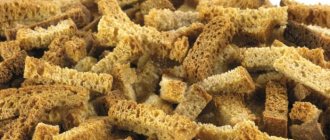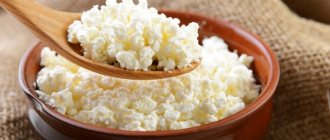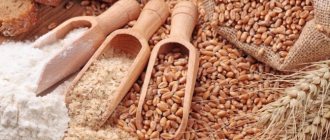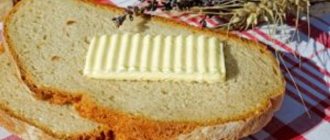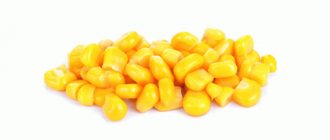Bread for gastrointestinal diseases
There are certain dietary rules for treating or preventing the disease. For example, during an exacerbation of gastritis, eating flour products is strictly prohibited. In the first days, they adhere to a strict diet, and liquid food is gradually introduced. Only then, after the condition has normalized, can you eat flour products, but in small quantities.
Gastroenterologists identify ingredients that should not be present in proper flour products:
- starch;
- margarine;
- leavening agents;
- dyes;
- preservatives;
- sugar;
- vegetable fat.
Bread made from such components should be excluded from the daily diet not only for gastritis, but also for duodenal and stomach ulcers. Such a product will only aggravate the situation and harm the diseased digestive system.
What bread is not recommended for gastritis?
If the form of the disease is mild, black bread for gastritis is allowed, but only in small quantities. At the same time, you should not eat dry food, so as not to provoke further development of the disease. For any type of gastritis, baked goods, fresh and especially warm bread are contraindicated.
What bread is not recommended for consumption with gastritis with high acidity?
For gastritis with high acidity, it is necessary to exclude from the diet bread that has a sour taste, such as Borodino bread. Its components stimulate the release of hydrochloric acid, causing irritation of the gastric mucosa, which does not contribute to recovery at all.
Rye bread may also contain flavoring additives that are poorly perceived by the diseased digestive system. In some cases, after eating bread products, pain symptoms may appear and complications may occur.
What bread is not recommended for consumption with gastritis with low acidity
For gastritis with low acidity, bran bread is excluded from the diet. It contains a large number of valuable elements and vitamins, but, in addition, it also contains fiber, which is difficult for the body to absorb in a state of illness.
Bran and grains can cause irritation of the mucous membrane. Black varieties of bread create a greater burden on the gastrointestinal tract, so it is better to refrain from eating it.
Rules for eating bread
For most people, food without bread is of no value; almost every meal they eat is accompanied by this fiber-rich product, which saturates the body due to the carbohydrates it contains. After consuming this product, a person’s mental activity improves, and his body gains the necessary strength for Active
For patients with gastritis, gastroenterologists strongly recommend giving up fresh bread. But dried or yesterday's can be eaten.
Whatever bread is chosen, it should be consumed in moderation. They cannot replace main courses such as salads, cereals, first courses and desserts. The main thing is to avoid any dry food; any flour products should be taken together with soup, jelly, tea, weak coffee or warm water. Any dry food for gastritis can cause not only an irritating effect on the mucous membranes of the digestive organs, but also interfere with their healing process and thereby support the inflammatory process and delay recovery.
When buying bread, diet bread or crackers, you need to look at their production date and check the composition of flour products; it is advisable to choose those types that do not contain spices and various additives in the form of seeds and nuts. If it’s difficult to find a suitable option, and eating food without bread is not a joy, then you can make your own croutons.
Eating bread for acute gastritis
When an acute process develops, the first days are fasting, after two days they eat exclusively liquid food in the form of jelly, porridge and broth. After a week, foods are selectively added to the diet. During this period, you need to be careful with your stomach and not eat foods that inflame the mucous membrane.
You should not consume fresh bread, which develops bloating and damage to the mucous membrane, increasing the secretion of gastric acid. For a similar reason, rich foods are excluded: pies, buns, cookies.
Gastritis with decreased secretion
This type of disease is characterized by a tendency to stagnation in the stomach due to difficulties with digestion and increased gas formation.
During the stage of severe exacerbation, it is recommended to avoid baked goods due to the damaging effects of dietary fiber and large amounts of carbohydrates.
If an exacerbation occurs without severe symptoms, on the 3-4th day it is possible to introduce yesterday’s wheat bread into the diet.
If there is a tendency to diarrhea, it is allowed to eat crackers made from wheat flour or stale white bread made from premium flour.
When the condition has stabilized, wheat bread made from grade I and II flour, baked savory products with lean meat and cottage cheese are recommended.
Bread you can eat with gastritis
Despite the bans on most types of baked goods, some of them are still allowed by gastroenterologists. Complete refusal of bread is possible only in acute forms of gastritis in the first stages of treatment.
White bread made from premium flour but not rich or fresh is the safest for gastritis
White bread made from premium flour, but not rich or fresh, is the safest for gastritis. It is best to eat it slightly dried. Barley bread is very well accepted by the stomach for gastritis. Yesterday's baked goods are much better digestible, because the fermentation processes have already stopped, and the gastric mucosa will not be irritated during digestion.
Baking homemade bread can be a salvation for people with chronic or acute gastritis. It is better not to include any additives, spices, or yeast in the dough.
Crackers are very well digested by a weakened stomach. However, spiced crackers should be avoided. You can dry the bread to achieve the state of crackers yourself. Then you will be sure that they do not contain harmful impurities. It is better to eat crackers together with liquid food or drinks; you can even pre-soak them before eating.
Erosive gastritis
Erosive gastritis is a disorder of the digestive tract due to the increased content of gastric juice, which destroys the inner lining, and the protective layer does not cope with its function. Why can't you eat bread if you have gastritis? Flour products contain margarines, starches, vegetable fats and leavening agents, which do not benefit the body, especially with erosive gastritis.
Failure to follow a diet can complicate the situation and harm the gastrointestinal tract. But dry cookies, oven-dried products or yesterday’s products are not prohibited.
What is bread, benefits and harms
Bread is one of the main products on the table of most people on earth . But today, flour products are prepared using a completely different technology, which in turn completely changes its structure.
This is due to the fact that all useful substances and microorganisms are found in the grain shell and in its germ, but according to new grain processing standards, all these parts are taken away and end up in waste.
As a result, only 30% of the healthy remains, and the rest is starch and calories, which are part of the first grade flour.
One of the unfortunate aspects of this is that these 30% of nutrients are quickly eliminated from the body, leaving all the calories to accumulate.
The consequences of taking a large amount of flour in the diet contributes to the accumulation of excess fat.
On our website: Dumplings for gastritis: secrets of preparing a dietary dish
Atrophic
The atrophic form of gastritis is when the cells of the stomach cannot produce enough gastric juice to process food, which negatively affects the functioning of the gastrointestinal tract. Very often this occurs due to exposure to Helicobacter pylori bacteria, which reduce the protective properties of the membrane and free radicals penetrate into tissues, damaging them. With atrophic gastritis, food is excluded that is difficult to digest, irritating the walls of the stomach, provoking fermentation.
Types of bread
The influence of bread on the activity of the gastrointestinal tract is determined by its composition and depends on the variety, method of preparation, as well as the grain crops used for its production:
- Factory or home. In the first case, special equipment and a strict recipe are used, in the second, culinary improvisations are possible during the preparation of the dough and baking in the oven or bread maker.
- Traditional (made from finely ground rye or wheat flour) or dietary (with the addition of buckwheat, barley, oats, bran).
- White or black. For the first, various varieties of ground wheat are used, for the second - rye.
- Yeast and yeast-free.
In addition, bakery products are produced in the form of: Each type has a different effect on the gastric mucosa and its motility, so doctors advise not to consume certain ones, and some are recommended for dietary nutrition.
Black
Black bread is usually called bread made from rye flour. This also includes a product made from two types of flour - rye and wheat. The ratio of ingredients may be different, the biological usefulness of the product depends on this.
Any black bread is healthy, it contains microelements, a large amount of fiber, vitamins, and valuable amino acids. However, a pure product made from rye flour has high acidity, up to 12%. The fiber contained in black bread is needed by the intestines, and is not at all useful to a sick stomach due to its traumatic effect.
Even a healthy stomach has difficulty digesting a 100% rye product - it takes about 4 hours. The optimal type of black bread, containing only 80% rye and 20% wheat, is digested a little faster, in 3.3 hours. But for patients, even mixed rye-wheat bread is a heavy and not recommended food. It increases acidity, is digested slowly, and injures the mucous membrane.
Conclusion: rye products are not recommended for high and normal acidity. In normal conditions, they are allowed in the stage of stable remission in small quantities - 30 grams 2 - 3 times a week in dried form.
White
If black bread is an original Russian product, then history attributes white bread to the Egyptians. It was they who first grew wheat and baked the well-known loaf, which is present in every home today. How can they not scold him because of his high carbohydrate content! But they forget about the nutritional value. Although white bread contains everything – vitamins, amino acids, and microelements. There is less fiber than in black, acidity is 7%, in sliced loaf it is 3%. Yeasted wheat bread takes 3 hours to digest, the yeast-free version takes 2.5.
Do you feel how the chances of wheat bread increasing to become mandatory in the diet of a patient with gastritis? So it is - wheat bread is allowed for gastritis. True, not warm, but yesterday’s, remember that.
Varieties without yeast
Is there bread without yeast? Happens. This is lavash and its varieties. All other varieties, if not prepared with the addition of yeast, are based on a leaven that “works” in the dough according to the same fermentation principle, no doubt. It is generally impossible to “raise” rye flour without yeast or leaven; with wheat flour the situation is a little simpler. However, the presence of porosity in the product is an accurate confirmation of the presence of fermentation processes. Therefore, a fashionable yeast-free product is a good advertising campaign, if it is not lavash.
The nutritional value of sourdough products is close to yeast varieties, so it is not of fundamental importance. So the choice of product is a matter of your taste preferences. And we talked about the rules of nutrition for gastritis above.
Whole and crushed grains
Any grain bread contains the following ingredients:
- Whole or crushed cereal grains. This is not necessarily rye or wheat; barley, rice, corn and other grains are successfully used in recipes.
- Yeast. They can be classic, as well as dry and liquid.
- A mixture of water and milk.
- Salt.
An interesting fact is that a real grain product cannot be white and fluffy - if the recipe contains unrefined grains, the bread has a dense consistency and a grayish color. And on fluffy white buns, grains can only be present as a topping.
Whole and crushed grains are harmful for gastritis. They injure the mucous membrane, take a long time to digest, and increase acidity. Therefore, patients with gastritis should avoid the shelf with grain baked goods.
Bran
Famous Moscow nutritionist A.V. Kovalkov believes that bran is essential in the diet. In his lectures, he says that bran is not digested, but only transits through the digestive tract, giving away all the valuable substances and taking away all the toxins. Bran is also called a “brush for the intestines”, due to its ability to enhance peristalsis. Yeast acts in the same way in bread, so bran baking is not advisable for patients with gastritis.
But there is an alternative: if you pour milk over the bran for half an hour, they will lose their “scratching” properties. Use them in this form for your health, you will get all the nutrients, and your intestines will work better.
With increased secretion, bran soaked in milk helps reduce acidity. Allowed for gastritis are oat and wheat bran, the rest are prohibited.
About crackers and crackers
It is crackers that are recommended for gastritis as bread products. True, not beer croutons, which are generously sprinkled with salt and spices, but the most ordinary ones, wheat or rye-wheat without additives.
If the acidity is low or zero, only wheat products are allowed. Rye - excluded.
The main advantages of crackers compared to bread products are as follows:
- Low humidity.
- Significantly reduced calorie content.
- Easy to digest product structure.
To eliminate traumatic properties, it is recommended to soak crackers and crackers for gastritis, just like bran. You can pour them with broth or yogurt, or even add them to porridge - you will retain the nutritional value of the product, and your stomach will easily cope with them.
Bread
Not all types of bread are suitable for patients with gastritis. Barley and wheat are allowed, rye is contraindicated. Rice, buckwheat, and corn bread can be consumed, but in limited quantities, no more than 100 grams per day and in soaked form. Variations - breads with filling and various additives are best excluded. The best choice is dietary wheat bread.
When purchasing, pay attention to the composition of the product - there should be no preservatives or stabilizers that harm a sore stomach. The shelf life of the bread is also important - for a patient with gastritis, those that are stored for 6 to 12 months are suitable. These products are better crushed, so they will not injure the mucous membrane.
Is it possible to have buns if you have gastritis?
Sweet foods and savory dough products contain yeast, which interferes with the proper digestion of food. They do more harm than good, especially to patients with gastritis. After eating such foods, belching, nausea and flatulence appear.
Cupcakes for gastritis
In case of acute gastritis, it is necessary to follow a strict diet, which requires the exclusion of cakes, pastries, and muffins from the diet. During this period, it is advisable not to eat fatty, sweet and starchy foods. But, there is a healthy pastry that replaces your favorite sweets - carrot cake. It is prepared easily, without the use of flour.
Lavash for gastritis
Lavash has two types of preparation - Armenian or Georgian. They differ from each other in appearance. The Armenian product is rolled out very thin and is used to prepare various snacks. The Georgian version is thicker and is used as a pizza base.
Lavash contains fiber, as well as microelements such as zinc, phosphorus, copper, magnesium and vitamins. With moderate consumption of this pastry, the immune system is strengthened and digestion is improved. The benefits of lavash will only be if high-quality and natural products are used for preparation, without yeast or flavoring additives.
Video on the topic:
Forbidden bread
Although white bread is safer among all others, even it cannot be consumed fresh. Hot bread is poorly digested in a sick stomach; it is better to eat it dried, but only without adding butter or sauce.
You can drink the dried product with water; this is even recommended by doctors.
Prohibited types of bread are:
- Baking with bran. It contains many microelements and nutrients that are beneficial for the body, but such bread is contraindicated for gastritis. Bran fibers have an irritating effect on the inflamed gastric mucosa, which does not allow it to heal for a long time. The stomach of a person suffering from gastritis with low acidity can especially suffer; the bran in it is not digested and fermentation begins, which leads to heaviness of the stomach and causes discomfort. If you ignore your doctor's advice and constantly take bran bread, it can lead to ulcers.
- Borodino variety. If there is high acidity, such bread should not be consumed. Many people like its sour taste, but it is this that causes the active release of hydrochloric acid, which destroys the walls of the stomach. Because of this, not only gastritis, but also peptic ulcers can worsen.
- Rye bread. It comes in several types; most manufacturers add different flavoring additives to improve the taste of such a flour product. But in any form, such bread will be difficult for a weakened stomach to cope with, since its fibers take a very long time to digest and irritate the mucous membrane of the digestive organ.
- The rich and salty dough from which bread is made is difficult to digest due to the yeast it contains and does more harm than good to the sick body. Fermentation during baking bread and after it enters the gastrointestinal tract continues, this causes bloating, belching and nausea.
- Doctors still allow patients with gastritis to eat black bread if they eat it in moderation and wash it down with water or other drinks.
Dry black bread is very dangerous for the stomach, even in small quantities.
Nowadays, bakery stores offer a wide range of flour products; most of them cannot be eaten by those suffering from gastritis, but there are varieties recommended for it.
What kind of bread to eat for gastritis
There are many different diseases of the gastrointestinal tract and each has its own table. For example, diet No. 1 is prescribed during the recovery period after a sharp exacerbation of stomach and duodenal ulcers, and diet No. 2 is prescribed for chronic gastritis with low acidity, chronic enteritis and colitis. As a rule, bread is included in the treatment menu.
Doctors choose a table based on the individual characteristics of the disease. Sometimes during an acute period bread is excluded from the diet for a couple of days. But usually they only limit its consumption. This product contains fiber (the key to normal gastrointestinal function), amino acids, vitamins and other useful substances.
The main thing is to know what type and variety is possible for your disease. The main recommendations for ulcers, gastritis, pancreatitis are moderation in food. The bread should not be fresh, but “yesterday’s” or dried. It should be eaten in small pieces, washed down with water. After the acute period has passed, eating healthy bread is not just acceptable, but mandatory. This will help a quick recovery, proper functioning of the gastrointestinal tract, and reduce the risk of relapse.
However, bread is healthy provided it has been stored properly. The optimal period is 3 days from the day of baking. At the same time, it is better to keep rye and wheat varieties separately, in disposable plastic bags. To extend the life of bread, you can freeze it. As for standards, WHO recommends that a healthy person eat 300-400 grams (6-8 slices) of bread per day. If you are overweight, limit consumption to 100-150 grams (3 pieces).
Allowed bread
As an alternative to regular bread, crackers prepared independently in the oven can be used, but you should not add oil and spices. They can be made from any type of bread, even prohibited ones; when dried, its components cannot affect the stomach.
If the disease proceeds as usual, and no exacerbations are observed, then you can eat a piece of Borodino bread a day. Other flour products in dried form can also be used. It is allowed to enjoy dry biscuits, long-lasting cookies and pies with cottage cheese made from soft dough.
During the acute phase, the patient should follow diet No. 1, according to which bread should be excluded from the diet along with vegetables, fruits and unhealthy foods. The diet should be followed for two weeks. Then you need to return to a softer diet, but at the same time exclude some foods from the diet, including forbidden bread.
During the remission stage, the patient can use:
- I love yesterday's baked goods. But rye and “Borodinsky” bread should be cut into small pieces and dried so that the acidity is removed from it and it becomes more acceptable to the stomach.
- During this period, crackers can be prepared from white wheat bread, but they should not be sprinkled with salt and spices; it is better to dip them in milk before eating. Dried crumbs of crackers, entering the digestive tract, can be perceived as abrasive inclusions and will make recovery very difficult, irritating the mucous membranes. For this purpose, buy low-fat varieties of milk; for those who, along with gastritis, have lactose intolerance, it can be replaced with kefir or yogurt. A loaf is ideal for crackers.
- Bakery products made from barley are also used dried. They are easily digested by the stomach and do not irritate its walls.
- Store-bought bread. As a dietary product, it officially entered a number of diets for diseases of the gastrointestinal tract relatively recently, but has become indispensable for the treatment of serious diseases. Flour for bread is selected taking into account the problems of the digestive organs; it is completely purified from various impurities and substances. They contain a lot of fiber, but in this form it is easily digested and does not block the normal activity of the stomach. But even this product, safe for gastritis, should be consumed in moderation.
Types of healthy bread
From all the variety on the shelves of the bread department, you can choose the truly right product that will not harm your sore stomach.
To do this, firstly, you need to adhere to the doctor’s recommendations, and secondly, do not forget about the basic properties of different types of product.
Product made from premium flour
Wheat flour of this type is not beneficial for the body, because it is refined - purified of all valuable nutrients. Products made from such flour are undesirable even for a healthy person. It is believed that the most useful are bakery products made from first and second grade flour.
For patients with gastritis of any form, the following are contraindicated:
- fresh bread;
- freshly prepared baked goods;
- sweet buns.
They contain yeast. When they enter the acidic environment of the stomach, they continue to ferment, causing indigestion and causing discomfort in the intestines. And as a result, bloating, dull pain, flatulence and poor health.
It is better to eat yesterday's baked goods in a dried form, as they are better absorbed, because the fermentation processes have already ended.
Proper bread
- White bread for gastritis is considered safe, but not rich or fresh, but yeast-free. This product is baked from first grade flour.
- Barley product is recommended for gastritis because it is easily digested by the stomach, does not cause stagnation and does not damage the mucous membrane.
- During remission of a chronic gastric disease, it is allowed to eat gray bread made from rye flour. The product improves the functioning of the digestive system and contains many nutrients.
- Rye bread for gastritis can be consumed, but no more than 2 pieces per day. In the acute stage, it is prohibited to eat it.
Crackers
Fresh bread has a high acid content, while bread crumbs contain practically no acids. Gastroenterologists recommend crackers even for gastritis with high acidity.
The best option would be if they are prepared at home. These crackers contain only healthy ingredients, and harmful impurities and additives are excluded.
Bread
Bread for gastritis is an ideal replacement for flour products. They are made without yeast, from low-grade flour, which significantly increases their dietary significance. The products are quickly absorbed without causing heaviness in the stomach, but on the contrary, they protect the mucous membrane from damage. They can be rye or wheat, corn or rice.
The product is rich in vitamins and microelements and serves as a source of fiber, which has a beneficial effect on the patient’s well-being. If consumed in moderation, there will be no harm.
Crispbread can be eaten if you have a stomach ulcer, only by first soaking it in liquid food: soup, milk, tea or compote.
To help the body fight gastritis, you must adhere to specific nutritional rules. A proper diet is an important component of a speedy and successful recovery. There is no need to completely give up bread, you just need to know what type and in what cases it is permissible to consume without harm to the body.
Yeast-free bread recipe
The best solution for gastritis is to prepare healthy bread at home. Making these baked goods yourself couldn’t be easier. There are many recipes. We offer you the most useful one, which can be safely included for gastritis and other diseases of the gastrointestinal tract.
To prepare you will need:
1 glass – low-fat milk;
1 cup – instant rolled oats;
1 table. l. – vegetable oil (preferably olive);
1 glass of wheat flour - (suitable for both premium and first grade);
2 table. l. – honey;
20 g – baking powder for dough;
¼ table. l. – salt.
How to cook:
- Hercules is crushed into fine crumbs using a food processor or blender.
- Salt, flour, and baking powder are added to the oatmeal.
- Mix milk, melted honey, and olive oil in a separate container.
- The vegetable-milk mass is gradually poured into the dry mixture, everything is thoroughly mixed.
- The dough is kneaded, it turns out pliable and not hard.
- The dough is formed into bread, placed on a baking sheet, or immediately placed in special forms for baking bread. The molds and baking sheet are pre-greased with oil.
- Bake in an oven preheated to 220 degrees for about 25-35 minutes. Readiness is checked this way: if you knock on the bottom of the molds, they begin to make a muffled sound.
- All you have to do is wait until the bread cools down and let it sit for a day. Or you can cut it into small pieces, dry it, and get delicious crackers.



